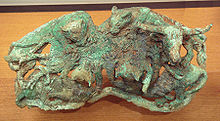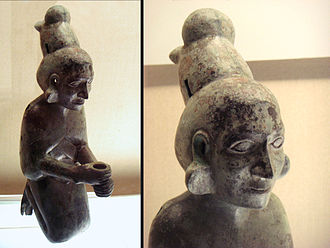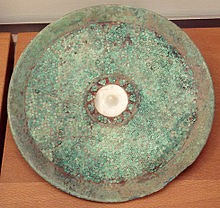- Dian Kingdom
-
Dian Kingdom
滇國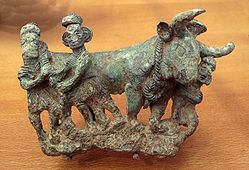
Bronze sculpture depicting Dian people, 3rd century BCE.Languages Unknown Religion Unknown Capital Unknown Area Northern Yunnan, China Existed 4th century BCE–109 BCE The Dian Kingdom (Chinese: 滇國 or 滇王國) was established by the Dian people, who lived around Lake Dian in northern Yunnan, China from the late Spring and Autumn Period until the Eastern Han Dynasty. The Dian buried their dead in vertical pit graves.[1] The Dian language was likely related to Tibeto-Burman languages.[2]
Contents
History
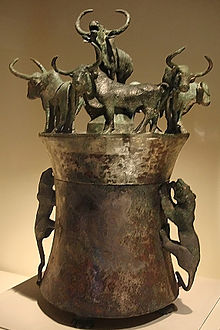 A bronze cowry shell vessel (cowry shells were once used as currency in China) with oxen and tigers, made by the Dian people during the Chinese Western Han period (202 BC – 9 AD)
A bronze cowry shell vessel (cowry shells were once used as currency in China) with oxen and tigers, made by the Dian people during the Chinese Western Han period (202 BC – 9 AD)
The Dian were first mentioned historically in Sima Qian's Shiji; according to Chinese sources, the Chinese Chu general Zhuang Qiao was the founder of the Dian Kingdom.[3] Chinese soldiers who accompanied him married the natives. Zhuang was engaged in a war in conquer the "barbarian" peoples of the area, but he and his army were prevented from going back to Chu by enemy armies, so he settled down and became King of the new Dian Kingdom.[4]
The kingdom was located around Kunming[5], it was surrounded, on its east, the Yeh-lang tribes, to the west, Kunming tribes, and to the north in Chengdu, by the Chinese, and had relations with all of them.[6]
It is said that during King Qingxiang's (Ching-hsiang) rule over Chu (298 236 BC), a military force was sent on a mission to the area which makes up the present day provinces of Sichuan, Guizhou, and Yunnan which respsectively were the lands of the Ba and Shu, Chinzong, and the Tien. Native women married the Chu soldiers, who stayed in the area.[7]
The Dian were subjugated by the Han Dynasty under the reign of Emperor Wu of Han in 109 BC.[8][9] The Dian King willingly received the Chinese invasion, in the hopes of assistance against rival tribes, it was at this time he received his seal from the Chinese, and became a tributary.[10] The Han Dynasty incorporated the territory of the Dian Kingdom into the Yizhou Commandery, but left the King of Dian as the local ruler, until a rebellion during Han Chao-ti's rule. The Chinese proceeded with colonization, and conquered the Kuming tribes in 86 and 82 B.C., reaching Burma.[11]
Royal burials
The Dian buried their kings at Shizhaishan (discovered in 1954). The burials were identified by the inscription, King Dian's Seal. The inscription was written in seal script on a gold imperial seal of investiture given by the Han Emperor.[12][13][14] Sima Qian noted that the Dian were one of only two local groups to have received an imperial seal, the other being Yelang. Both are still known - the Yelang seal emerged in 2007 from a Miao man in Guizhou, claiming to be the Yelang king's 75th generation descendant.[15]
Bronze working
The Dian people were sophisticated metal workers, casting both bronze and iron. The Dian cast bronze objects using both the piece mould method and the lost wax method. Dian elite burials contained an impressive array of bronze objects, although late Dian burials also contained locally cast iron objects.
Large bronze drums were employed by the Dian to communicate in battle; ritual burials of Dian elites were accompanied by large bronze drums filled with cowrie shells. The tops of the drums were removed and replaced by a bronze lid.
Scythian influences?
Iaroslav Lebedynsky and Victor Mair speculate that some Scythians may also have migrated to the area of Yunnan in southern China following their expulsion by the Yuezhi in the 2nd century BCE. Excavations of the prehistoric art of the Dian civilization of Yunnan have revealed hunting scenes of Caucasoid horsemen in Central Asian clothing.[16] The scenes depicted on these drums sometimes represent these horsemen practicing hunting. Animal scenes of felines attacking oxes are also at times reminiscent of Scythian art both in theme and in composition.[17]
Depiction of Dian society
The bronze lids were covered with miniature figurines and structures, depicting various scenes from the life of the Dian people. The bronze lids depicted the Dian people engaged in everyday activities such as hunting, farming and weaving. Other scenes depicted the leisurely pursuits of the Dian people, such as bullfighting, dancing and music-making. The Dian people dressed in tunics over short pants and wore their hair in topknots. The bronze lids corroborated Sima Qian's description of the Dian hairstyle.
Many scenes depicted the Dian at war, often riding horses. Archaeological evidence shows that horses had been domesticated by the Dian people as early as the sixth century BC. The bronze lids also depicted the Dian decapitating their enemies (who wore their hair in long plaits).
The Kingdom was based on agriculture, the bronzes also showed head hunting, human sacrifice, and slaves as part of Dian society.[18][19][20][21]
Underwater ruins
Main article: Lake FuxianArchaeologists recently discovered the inundated remains of Dian-period buildings and pottery fragments under Lake Fuxian and were able to verify their age with carbon dating.
Other Artifacts
At Dabona, a site connected with the Dian culture, archaeologists discovered a large double coffin burial; The outer coffin was made of wood and the inner coffin was made of bronze. The inner coffin was shaped like a house and weighs over 157 kg.
The Yunnan Provincial Museum holds many archaeological relics of the Dian culture.
See also
- Yelang
- Zomia (geography)
Notes
- ^ Archaeology of Asia, pp. 247
- ^ The Peopling of East Asia, pp. 192
- ^ Patrick Manning (2006). World history: global and local interactions. Markus Wiener Publishers. p. 34. ISBN 1558763953. http://books.google.com/books?id=XFcAjvlW41QC&pg=PA34&dq=nanzhao+mongol+dian&hl=en&ei=Sva8TbnPI8Th0gGdsZ24BQ&sa=X&oi=book_result&ct=result&resnum=4&ved=0CDkQ6AEwAw#v=onepage&q=nanzhao%20mongol%20dian&f=false. Retrieved 15 May 2011.
- ^ Stephen Mansfield, Martin Walters (2007). China: Yunnan Province (2, illustrated ed.). Bradt Travel Guides. p. 7. ISBN 1841621692. http://books.google.com/books?id=5mU5dN3mDeIC&pg=PA7&dq=nanzhao+mongol+dian&hl=en&ei=Sva8TbnPI8Th0gGdsZ24BQ&sa=X&oi=book_result&ct=result&resnum=5&ved=0CD4Q6AEwBA#v=onepage&q=nanzhao%20mongol%20dian&f=false. Retrieved 15 May 2011.
- ^ Piper Rae Gaubatz (1996). Beyond the Great Wall: urban form and transformation on the Chinese frontiers (illustrated ed.). Stanford University Press. p. 77. ISBN 0804723990. http://books.google.com/books?id=drGGEsi1fFEC&pg=PA77&dq=nanzhao+mongol+dian&hl=en&ei=Sva8TbnPI8Th0gGdsZ24BQ&sa=X&oi=book_result&ct=result&resnum=1&ved=0CCoQ6AEwAA#v=onepage&q&f=false. Retrieved 15 May 2011.
- ^ Jacques Gernet (1996). A history of Chinese civilization. Cambridge University Press. p. 124. ISBN 0521497817. http://books.google.com/books?id=jqb7L-pKCV8C&printsec=frontcover&dq=A+history+of+Chinese+civilization&hl=en&src=bmrr&ei=boPQTc2wCs2RgQf618y5DA&sa=X&oi=book_result&ct=result&resnum=1&ved=0CEIQ6AEwAA#v=onepage&q=tien%20kingdom%20k'un-ming%201956&f=false. Retrieved 15 May 2011.
- ^ Jacques Gernet (1996). A history of Chinese civilization. Cambridge University Press. p. 73. ISBN 0521497817. http://books.google.com/books?id=jqb7L-pKCV8C&printsec=frontcover&dq=a+history+of+chinese&hl=en&ei=MrT1TLPnJ8KclgeQ4PjfBQ&sa=X&oi=book_result&ct=result&resnum=2&ved=0CDQQ6AEwAQ#v=snippet&q=yunnan%20tien%20soldiers%20ch'u%20married%20local%20women&f=false. Retrieved 2011-05-08.
- ^ Stephen G. Haw (2006). Marco Polo's China: a Venetian in the realm of Khubilai Khan (illustrated ed.). Psychology Press. p. 13. ISBN 0415348501. http://books.google.com/books?id=CdE6Q_2yICIC&pg=PA13&dq=nanzhao+mongol+dian&hl=en&ei=Sva8TbnPI8Th0gGdsZ24BQ&sa=X&oi=book_result&ct=result&resnum=2&ved=0CC8Q6AEwAQ#v=snippet&q=dian%20yizhou%20lake%20yunnan&f=false. Retrieved 15 May 2011.
- ^ Stephen Shennan (1989). Archaeological approaches to cultural identity (illustrated ed.). Unwin Hyman. p. 195. ISBN 0044450168. http://books.google.com/books?ei=w5rQTa_2JOf00gHs-p3nDQ&ct=result&id=Yv8MAQAAMAAJ&dq=can+be+seen+in+Lalo%2C+or+Yi+and+its+related+groups%3B+others+%28head-hunting%2C+pile-+dwellings+decorated+with+two+birds+on+the+roof%2C+etc.%29+are+to+be+found+among+the+Wa.+The+custom+of+using+bronze+drums+in+festivals+or+ceremonies+was+still&q=dian. Retrieved 15 May 2011.
- ^ Patrick R. Booz (2007). Yunnan (3, illustrated ed.). Passport Books. p. 11. ISBN 9622172105. http://books.google.com/books?ei=Sva8TbnPI8Th0gGdsZ24BQ&ct=result&id=xf4JAQAAMAAJ&dq=nanzhao+mongol+dian&q=seal++dian. Retrieved 15 May 2011.
- ^ Jacques Gernet (1996). A history of Chinese civilization. Cambridge University Press. p. 125. ISBN 0521497817. http://books.google.com/books?id=jqb7L-pKCV8C&printsec=frontcover&dq=A+history+of+Chinese+civilization&hl=en&src=bmrr&ei=boPQTc2wCs2RgQf618y5DA&sa=X&oi=book_result&ct=result&resnum=1&ved=0CEIQ6AEwAA#v=snippet&q=tien%20kingdom%20prince&f=false. Retrieved 15 May 2011.
- ^ Charles Higham (2004). Encyclopedia of ancient Asian civilizations (illustrated ed.). Infobase Publishing. p. 93. ISBN 0816046409. http://books.google.com/books?id=H1c1UIEVH9gC&pg=PA93&dq=dian+head+hunting+yunnan&hl=en&ei=HY_QTfCeKKW90AH-_tzfDQ&sa=X&oi=book_result&ct=result&resnum=4&ved=0CHUQ6AEwAw#v=onepage&q=dian%20head%20hunting%20yunnan&f=false. Retrieved 15 May 2011.
- ^ Jacques Gernet (1996). A history of Chinese civilization. Cambridge University Press. p. 198. ISBN 0521497817. http://books.google.com/books?id=jqb7L-pKCV8C&printsec=frontcover&dq=A+history+of+Chinese+civilization&hl=en&src=bmrr&ei=boPQTc2wCs2RgQf618y5DA&sa=X&oi=book_result&ct=result&resnum=1&ved=0CEIQ6AEwAA#v=snippet&q=tien%20kingdom%201956%20seal%20yunnan&f=false. Retrieved 15 May 2011.
- ^ David Leffman, Simon Lewis, Jeremy Atiyah, Simon Farnham, Mark South (2008). The Rough Guide to China (5, illustrated ed.). Penguin. ISBN 1843538725. http://books.google.com/books?id=pK7bfiqpBP8C&pg=PT1454&dq=nanzhao+mongol+dian&hl=en&ei=Sva8TbnPI8Th0gGdsZ24BQ&sa=X&oi=book_result&ct=result&resnum=8&ved=0CEwQ6AEwBw#v=snippet&q=golden%20seal%20dian%20into%20private%20statelets&f=false. Retrieved 15 May 2011.
- ^ "Seal of ancient king made public". CRI.cn. 2007-11-01. http://www.china.org.cn/english/culture/230489.htm. Retrieved 2010-08-19.
- ^ "Les Saces", Iaroslav Lebedynsky, p.73 ISBN 2877723372
- ^ "The Tarim Mummies", Mallory and Mair, ISBN 0500051011, p329-330
- ^ Charles Higham (1996). The Bronze Age of Southeast Asia (illustrated ed.). Cambridge University Press. p. 139. ISBN 0521565057. http://books.google.com/books?id=syRlCA6a0AsC&pg=PA139&dq=dian+head+hunting+yunnan&hl=en&ei=HY_QTfCeKKW90AH-_tzfDQ&sa=X&oi=book_result&ct=result&resnum=3&ved=0CHAQ6AEwAg#v=onepage&q=dian%20head%20hunting%20yunnan&f=false. Retrieved 15 May 2011.
- ^ Stephen Mansfield, Martin Walters (2007). China: Yunnan Province (2, illustrated ed.). Bradt Travel Guides. p. 6. ISBN 1841621692. http://books.google.com/books?id=5mU5dN3mDeIC&pg=PA6&dq=dian+head+hunting+yunnan&hl=en&ei=HY_QTfCeKKW90AH-_tzfDQ&sa=X&oi=book_result&ct=result&resnum=1&ved=0CGYQ6AEwAA#v=onepage&q=dian%20head%20hunting%20yunnan&f=false. Retrieved 15 May 2011.
- ^ Patrick R. Booz (2007). Yunnan (3, illustrated ed.). Passport Books. p. 11. ISBN 9622172105. http://books.google.com/books?ei=Sva8TbnPI8Th0gGdsZ24BQ&ct=result&id=xf4JAQAAMAAJ&dq=nanzhao+mongol+dian&q=seal++dian. Retrieved 15 May 2011.
- ^ Bradley Mayhew, Korina Miller, Alex English (2002). South-West China (2, illustrated ed.). Lonely Planet. p. 52. ISBN 186450370X. http://books.google.com/books?id=sm-2FZavr9QC&pg=PA52&dq=dian+head+hunting+yunnan&hl=en&ei=HY_QTfCeKKW90AH-_tzfDQ&sa=X&oi=book_result&ct=result&resnum=6&ved=0CH0Q6AEwBQ#v=onepage&q=dian%20head%20hunting%20yunnan&f=false. Retrieved 15 May 2011.
References
- Allard, Francis, 1999, The archaeology of Dian: trends and tradition. Antiquity 73(279): 77-79.
- Higham, Charles, The Bronze Age of Southeast Asia, ISBN 0-521-56505-7
- Sagart, Laurent, Roger Blench and Alicia Sanchez-Mazas (eds), The Peopling of East Asia ISBN 0-415-32242-1
- Stark, Miriam T. (ed), Archaeology of Asia, ISBN 1-4051-0213-6
- Yang, Bin, 2004, Horses, silver, and cowries: Yunnan in global perspective. Journal of World History 15(3): 281-322.
- "Les Saces", Iaroslav Lebedynsky, Editions Errances, ISBN 2877723372 (French)
- "The Tarim Mummies", Mallory and Mair, Thames and Hudson, ISBN 0500051011
External links
- Pictures of Dian Bronzeware
- More pictures of Dian Bronzeware (from German Wikipedia)
Categories:- Ancient peoples of China
- Archaeology of China
- Former countries in Chinese history
- Former monarchies of Asia
- History of Yunnan
- 109 disestablishments
- States and territories established in the 4th century BC
- Underwater ruins
Wikimedia Foundation. 2010.


